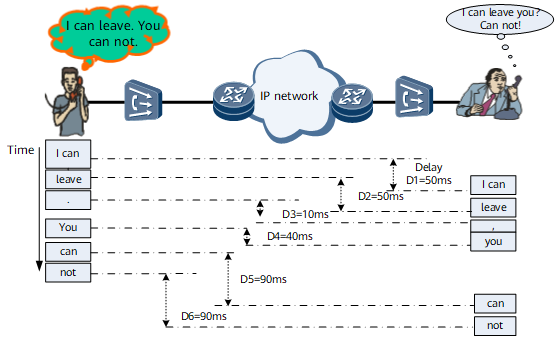QoS Specifications
QoS provides customized service guarantees based on the following specifications:
- Bandwidth/throughput
- Delay
- Delay variations (Jitter)
- Packet loss rate
Bandwidth/Throughput
Bandwidth, also called throughput, refers to the maximum number of bits allowed to transmit between two ends within a specified period (1 second) or the average rate at which specific data flows are transmitted between two network nodes. Bandwidth is expressed in bit/s.
As services become increasingly diversified, Internet Citizens expect higher bandwidths so they cannot only browse the Internet for news but also experience any number of popular applications. The epoch-making information evolution continually delivers new and attractive applications, such as new-generation multimedia, video transmission, database, and IPTV, all of which demand extremely high bandwidths. Therefore, bandwidth is always the major focus of network planning and provides an important basis for network analysis.


Two concepts, upstream rate and downstream rate, are closely related to bandwidth. The upstream rate refers to the rate at which users can send or upload information to the network, and the downstream rate refers to the rate at which the network sends data to users. For example, the rate at which users upload files to the network is determined by the upstream rate, and the rate at which users download files is determined by the downstream rate.
Delay
A delay refers to the period of time during which a packet is transmitted from a source to its destination.
Use voice transmission as an example. A delay refers to the period during which words are spoken and then heard. If a long delay occurs, voices become unclear or interrupted.
Most users are insensitive to a delay of less than 100 ms. If a delay ranging from 100 ms to 300 ms occurs, the speaker can sense slight pauses in the responder's reply, which can seem annoying to both. If a delay greater than 300 ms occurs, both the speaker and responder obviously sense the delay and have to wait for responses. If the speaker cannot wait but repeats what has been said, voices overlap, and the quality of the conversation deteriorates severely.

Delay variations (jitter)
Jitter refers to the difference in delays of packets in the same flow. If the period before a packet that has reached a device is sent by the device differs from one packet to another in a flow, jitters occur, and service quality is negatively affected.
Specific services, especially voice and video services, are zero-tolerant of jitters, which causes interruptions in voice or video services.

Jitters also affect protocol packet transmissions. Specific protocol packets are transmitted at a fixed interval. If high jitters occur, such protocols alternate between Up and Down, adversely affecting quality.
Jitter thrives on networks but service quality will not be affected if jitters do not exceed a specific tolerance. Buffers can alleviate excess jitters but prolong delays.
Packet Loss Rate
Packet loss occurs when one or more packets traveling across a network fail to reach their destination. Slight packet loss does not affect services. For example, users are unaware of the loss of a bit or a packet in voice transmissions. If a bit or a packet is lost in video transmission, the image on the screen becomes momentarily garbled but the image recovers very quickly. Even if TCP is used to transmit data, slight packet loss is not a problem because TCP instantly retransmits the packets that have been lost. If severe packet loss does occur, however, packet transmission efficiency is affected. The packet loss rate indicates the severity of service interruptions on networks and concerns users.
